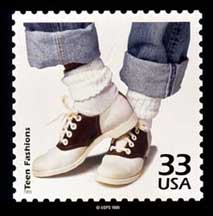
Group Dances of the 1950s
Come, let's Stroll!
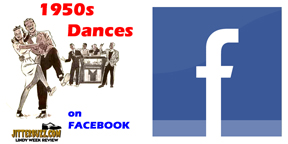
Join Us on Facebook
Just in case you have a special request, here are some navigational tools
- Overview of 1950s Dancing
- The Stroll
- The Jitterbug Stroll (Not a 1950s Dance)
- The Hand Jive
- The Madison
In addition to these 1950s dances, we have a Calendar of Swing Dancing in DC, a Directory of Vintage Clothing Stores and a Guide to 1940s Collectibles. Thanks for tuning in!
We did a whole lot of searching for information about the evolution of dancing. We found this "Time Line" on a C&.W website somewhere in Texas. (I forgot to write down the source, sorry...). This may not be authoritative, but it sounds right. So, without further ado, the Evolution of American Dance:
- pre 1890 Waltz, Quadrille, Minuet, Gavotte
- 1890's Polka, Schottische, Cotton Eyed Joe
- 1900-1920 Foxtrot, Turkey Trot, Peabody, Charleston
- 1920-1930 Jive, Lindy Hop
- 1930-1940 Rumba, Samba, Tango
- 1940-1950 Mambo, West Coast Swing
- 1950-1960 Cha Cha, Bosa Nova, Stroll
- 1960-1970 Monkey, Jerk, Mashed Potato, Madison
For two nights Ellen and Marc gave us a little more insight into the mysteries of dancing after 1950. Specifically they focused on three group dances of the period: The Stroll, the Hand Jive, and the Madison.
By the way, they will be repeating this class -- check their website for details
The word stroll can be used to refer to any repeating formation line dance. If you search YouTube, you'll find lots of modern "strolls". However, if yo have come to this website, you are probably looking for "The Stroll", the classic line dance of the 1950's. It is performed to slow swing and rhythm and blues The stroll is popular throughout the swing scene in Europe (strange as it's an American dance). Less danced in the US, it's addictive so that this will soon change, especially if Ellen and Marc have anything to do with it.... However, "The Stroll" of the 1950s should not be confused with another Lindy-Related group dance called The Jitterbug Stroll, as discussed below.
Music
You can do "The Stroll" to loads of swing music. Popular choices include - On Revival Day (Lavern Baker), Lavender Coffin (Lionel Hampton) and My Baby Just Cares For Me (Nina Simone), or"C.C. Ryder" (Chuck Willis). Strolling was popular on American Bandstand and is also part of the film American Graffiti (George Lucas), done to the eponymous song The Stroll created by The Diamonds after the craze began.
Origins
The emergence of "The Stroll" as a recognizable dance is due in large part to American Bandstand, a popular televised dance party that began in 1954. Initially, the show's regulars created the popular dance called the Bunny Hop. Following this success, the kids began churning out new dances for every new beat, including The Stroll, a slow, simple dance, where two lines - boys on one side, girls on the other - faced each other, shifting from left to right, then back again. The fun came when the couple met in the middle to strut down the aisle, all eyes on them. The dance was inspired by Chuck Willis' hit C.C. Rider. It became so popular that Willis was dubbed "King of the Stroll." But the dance soon got a song of its own when Dick Clark suggested to the Diamonds that they create a song specifically for the dance. The Diamonds were already hot with their hit Lil Darlin' (1957), struck gold again with The Stroll --- famous for its opening line,"Come, let's Stroll.". For us Lindy Hoppers, Chuck Willis vs. the Diamonds is sort of reminiscent of the debate about The Jitterbug Stroll (one of our group dances) --- should it be done to Woodchopper's Ball or the called version by Steven Mitchell?
The Steps
The stroll is done in two parallell lines (leads on one side, follows across the divide.) A simple basic step-pattern is performed in such a fashion that the line advances, or moves one pace with each pattern. Individuals on each end pair up and perform a "shine" routine as they proceed down the line; at the end, they separate and rejoin the lines. This formulation is part of many "contra" dances that were done in the US and Europe for centures. Thus, in one sense, the Stroll has been with us for a long time.
Here is our best verbal attempt to capture the essence of the "stroll step" -- it will help you decipher the video link given below. If you can improve on this, or if you have an instructional video, please Contact Us and we'll be glad to put it on the site!
Stand, feet about 24" apart. (this is "open")- Cross right over left (i.e. weight on left, cross with right and go back to open stance)
- Back to "open"
- Cross right over left
- Back to "open"
- Left foot behind and to the right of your right foot
- hold, weight on left, almost leaning back
- Move right foot to the right so that you are standing with feet apart, left slightly behind you must move the right foot so that it is about 10-12 inches from where it started
- Move left foot forward, in same line as right to "open"
You are now standing with feet apart in open stance but about a foot to the right of where you started The next bar (8 counts) is the mirror image
- Cross with Left over right
- Back to "open"
- Cross with left over Right
- Back to "open"
- Step right 12 "
- Left behind right, weight on left
- hold, weight on left, almost lean back
- step with left to "open"
The opposite line does the mirror image of this. Boys in one line, girls in the other.
At the top of the next bar, the persons on each end join in closed position and execute twirls, promenades, etc, etc as they proceed to the far end of the lines where they separate and become part of the line again. With each bar, the line advances so that a new couple forms and begins the promenade.
Here are our friends Sue and Gary teaching the Stroll while the kids on "Reston Bandstand" perform it.
Here are some pictures of Ellen and Marc's class doing The Stroll:
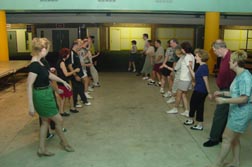

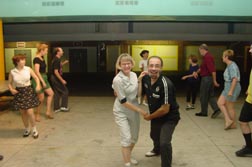
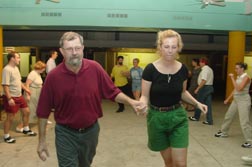

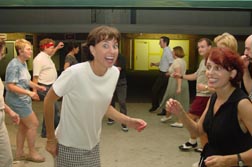
Photo Credit: Vern Hensley
The Jitterbug Stroll is a swing line dance choreographed in 1992 by Ryan Francois, a Lindy Hop dancer and teacher. It is usually danced to swing music with 12 bar blues structure such as Woody Herman's "Woodchopper's Ball" or Steven Mitchell's "The Jitterbug Stroll", a modern song created for this choreography. The dance is very popular among Lindy Hoppers, like the Shim Sham. Don't confuse "The Stroll" with "The Jitterbug Stroll" as shown in this video of our friends Pam and Steve Springer and their crew "Hub City Lindy Hop":
- Movement 1 - BaDa Bada
- Movement 2 - Knee Slap and Shorty George
- Movement 3 - Susie Q
- Movement 4 - Tick Tock
Instructional videos by Mike and Tina Foley of Head Over Heels Dance
The Hand Jive was a phenomenon in the summer of 1958 -- I was 14 and it seemed to be everywhere. My research indicates that it was in the Top Ten for 16 weeks -- to remain popular with fickle teenagers for almost four months was nothing short of astounding! However, to understand the Hand Jive properly, we must delve into the career of John Velioties a.k.a Johnny Otis
Born on Dec 28, 1921 in Vallejo, CA as Johnny Veliotes. Johnny Otis has modeled an amazing number of contrasting musical hats over a career spanning more than half a century. Bandleader, record producer, talent scout, label owner, nightclub impresario, disc jockey, TV variety show host, author, R&B pioneer, rock & roll star -- Otis has answered to all those descriptions and quite a few more. Not bad for a Greek-American who loved jazz and R&B so fervently that he adopted the African-American culture as his own.
California-born John Veliotes changed his name to the blacker-sounding Otis when he was in his teens. Drums were his first passion -- he spent time behind the traps with the Oakland-based orchestra of Count Otis Matthews and kept time for various Midwestern swing outfits before settling in Los Angeles during the mid-'40s and joining Harlan Leonard's Rockets, then resident at the Club Alabam.
It wasn't long before the Alabam's owner entreated Otis to assemble his own orchestra for house-band duties. The group's 1945 debut sides for Excelsior were solidly in the big-band jazz vein and included an arrangement of the moody "Harlem Nocturne" that sold well. The Otis outfit continued to record for Excelsior through 1947 (one date featured Big Jay McNeely on sax), but his influence on L.A.'s R&B scene soared exponentially when he and partner Bardu Ali opened the Barrelhouse Club in Watts. R&B replaced jazz in Otis's heart; he pared the big band down and discovered young talent such as the Robins, vocalists Mel Walker and Little Esther Phillips, and guitarist Pete Lewis that would serve him well in years to come.
Otis signed with Newark, NJ-based Savoy Records in 1949, and the R&B hits came in droves: "Double Crossing Blues," "Mistrustin' Blues," and "Cupid's Boogie" all hit number one that year (in all, Otis scored ten Top Ten smashes that year alone!); "Gee Baby," "Mambo Boogie," and "All Nite Long" lit the lamp in 1951, and "Sunset to Dawn" capped his amazing run in 1952 (vocals were shared by Esther, Walker, and other members of the group).
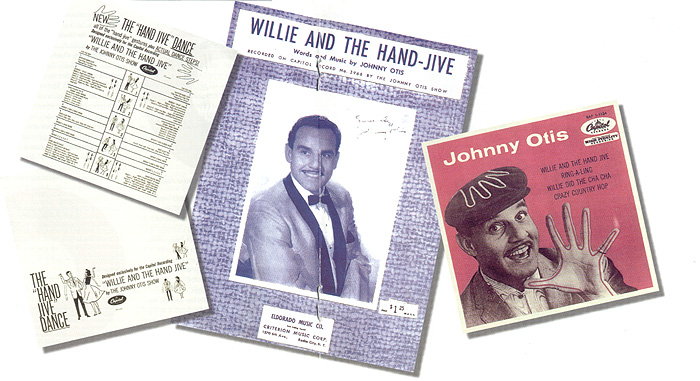
In recent years, Otis has been operating a California health-food emporium. If blues boasts a renaissance man amongst its ranks, Johnny Otis surely fills that bill.
Click here to hear the song Willie and the Hand Jive and to read the words and music. This is a .WAV file, so it does not really require broadband internet service
Click Here to see the Johnny Otis Show actually doing the Hand Jive. Click here to watch teens from American Bandstand doing their own version of the Hand Jive.
The dance consists of various hand movements (Slap thighs, cross palms, pound fists, touch elbows, hitch-hike). It is incredibly easy to learn, since it is repeated without change over six choruses of the song. No wonder EVERYONE in 1958 could do the Hand Jive! In the class, Ellen and Marc added footwork to the Hand Jive. They formed the group into two circles which rotated in opposite directions. I really don't think that words are going to describe this, but you might get a good idea from the pictures of what is going on here. This was a whole lot of fun! The gang looks forward to performing this (and getting you to join in...) at a dance soon.

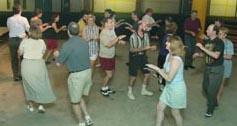
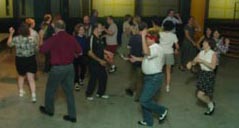
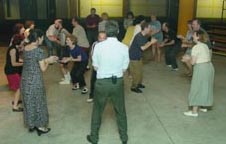
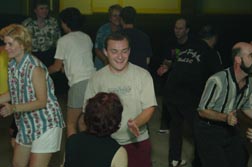
Photo Credit: Vern Hensley
The Madison is an amusing line dance that originated in the late 1950's. According to Lance Benishek (dance historian), "The Madison probably started in Chicago, although it may have been Detroit or Cleveland. The Baltimore Colts learned it in Cleveland and brought it to Baltimore in 1959." It is danced to the Ray Bryant tune, The Madison Time, with calls for the particular dance sequences provided by Eddie Morrison. Eddie was a Baltimore disc jockey who started calling the steps live on the air. On the other hand, here is a website that claims Columbus, Ohio as the home of the Madison.
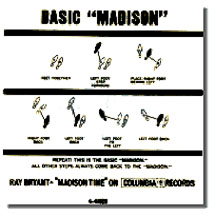
Basic Step for the Madison
Click to Enlarge
Based on a six count chorus step, The Madison contains several dance sequences which make playful references to 1950s and 1960s Television shows (e.g. The Rifleman) sports stars (e.g. Wilt Chamberlain) and performers (e.g. Jackie Gleason)
The Madison can be seen in the 1988 movie "Hairspray", and the song most used nowadays is the version on the soundtrack of that movie. In Baltimore, the Madison was done to generic music with the DJ calling the figures. There was one record made which included calls for some of the more common figures on the record. One local radio DJ, Jack Gail, came out with a comedy version including one call to hold both feet up off the ground at the same time. Here is a Video of the cast of Hairspray doing the Madison. Here is a video of the Kids on the Buddy deane Show doing the Madison. [ Compared to Madison Time, considerably fewer calls are used in this version.]
More Madison Sources:
- Ray Bryant CD with a bunch of called Madison Variants
- The history of Bell Records and their link to The Madison
- A fairly comprehensive Index of Dance Fads

Ellen doing the Rifleman
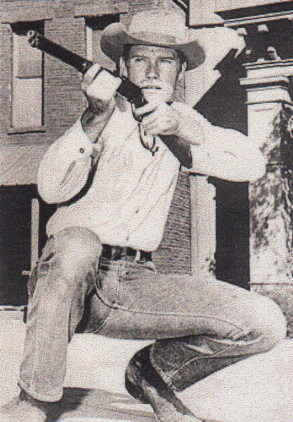
Chuck Connors doing the Rifleman
Other Madison Steps
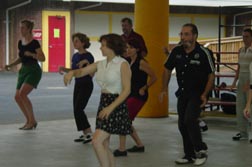
Basketball with the Wilt Chamberlain Hook
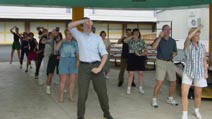
The Cleveland Box

Jackie Gleason's Epitaph
Photo Credit: Vern Hensley

Join Us on Facebook
Counter for the Entire Site (not just this page..)
Home | About Lindy | 1940s Collectibles | Upcoming Events | Vintage Clothing
The Guide - Establishments - Travel - Accessories
Music | Links | Photo Gallery | Extras | Contact